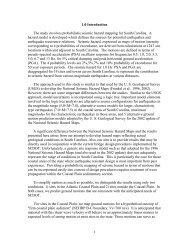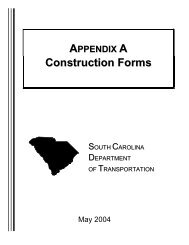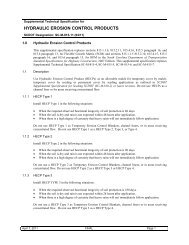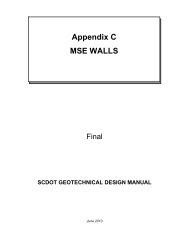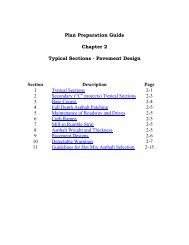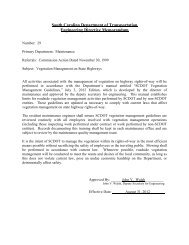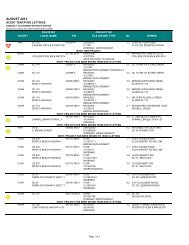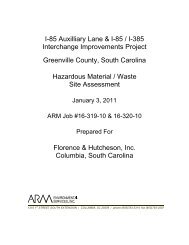PAVEMENT SCOPE OF WORK US-301/I-95 Interchange ... - SCDOT
PAVEMENT SCOPE OF WORK US-301/I-95 Interchange ... - SCDOT
PAVEMENT SCOPE OF WORK US-301/I-95 Interchange ... - SCDOT
You also want an ePaper? Increase the reach of your titles
YUMPU automatically turns print PDFs into web optimized ePapers that Google loves.
To provide continuity when tying onto existing I-<strong>95</strong> pavement, perform the following steps in<br />
whatever order is necessary to stage the construction safely and efficiently:<br />
Minimally micromill 3 inches from the existing mainline to remove the Open Graded<br />
Friction Course (OGFC) (approximately 1 inch thick) and the top lift of Asphalt Surface<br />
(approximately 2 inches thick). This should leave approximately 2 inches of Asphalt<br />
Surface and variable amounts of asphalt leveling over the original I-<strong>95</strong> concrete<br />
pavement.<br />
Construct new concrete pavement structure for the tie-ins to the elevation of the original<br />
I-<strong>95</strong> concrete pavement. It is not necessary to tie the new concrete to the existing or<br />
place expansion material between the old and new pavements. However, include a<br />
coating of curing compound on the side of the existing pavement at twice the required<br />
rate for new concrete to inhibit bonding prior to paving.<br />
Overlay the concrete in the transition with 200 psy Asphalt Surface Type B to the<br />
elevation of the mainline after micromilling.<br />
Overlay the I-<strong>95</strong> mainline and transitions with 200 psy Asphalt Surface Type A and 110<br />
psy OGFC.<br />
Carry the ramp asphalt to beyond the gore areas, then provide a neat transverse transition<br />
to the concrete surface. Construct two variable thickness transition slabs to provide a<br />
“step” into which the asphalt may be terminated. The first transition would terminate the<br />
Asphalt Surface Type B and the second transition would terminate the Asphalt Surface<br />
Type A and the OGFC.<br />
Concrete surfaces that will be overlaid with asphalt as part of this work may be left roughly<br />
textured to provide a better bond with the asphalt.<br />
To tie into existing <strong>US</strong>-<strong>301</strong>, construct the initial slab at the asphalt/concrete joint at variable<br />
thickness ranging from 15 inches at the free end to 10 inches at the first contraction joint. Mill<br />
the existing asphalt 2” and replace the milled material with 200 psy Asphalt Surface Type A.<br />
Ltd Road/Kenlake Court Access Road<br />
Construct either a concrete or asphalt pavement. For the concrete pavement alternative,<br />
construct a plain jointed concrete section with the following characteristics:<br />
Thickness: 6”<br />
Transverse Joint Spacing: 12’<br />
Transverse Load Transfer: None<br />
Longitudinal Joint Spacing: 15’ maximum<br />
Longitudinal Reinforcement: #4 deformed bar, 30” long, 30” c-c<br />
Surface Texture: Transverse Tine<br />
Joint Sealant: None. Single cut width longitudinal and transverse<br />
Nominal 28-day Compressive Strength: 4000 psi



